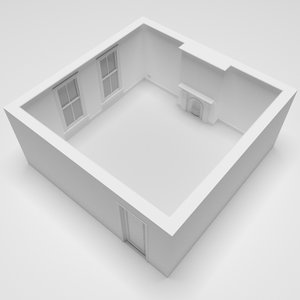Embark on a journey into the realm of 3D room models, where creativity meets innovation. Discover how these digital representations revolutionize industries and transform design concepts into immersive experiences.

Unveil the process of crafting intricate 3D room models from scratch, exploring the tools and techniques that bring virtual spaces to life with realism and precision.
Introduction to 3D Room Models
A 3D room model is a digital representation of a room or space created using specialized software to provide a three-dimensional view. These models are used in various industries for different purposes, such as architecture, interior design, real estate, and virtual staging.
Importance of 3D Room Models
3D room models play a crucial role in visualizing and planning architectural projects, interior designs, and real estate presentations. They offer a realistic view of the space, allowing professionals to make informed decisions and clients to visualize the final outcome accurately.
Use of 3D Room Models in Architecture and Interior Design
In architecture, 3D room models are used to create detailed floor plans, visualize building structures, and present design concepts to clients. Interior designers use these models to experiment with furniture placement, color schemes, and decor elements before implementing them in real spaces.
Software for Creating 3D Room Models
- Autodesk Revit: A popular software for creating detailed 3D models of buildings and interiors.
- SketchUp: Known for its user-friendly interface and versatility in creating 3D models of rooms and furniture.
- 3ds Max: Used for creating high-quality visualizations of interiors, lighting, and textures.
- Blender: An open-source software with a wide range of tools for creating 3D room models and animations.
Creating a 3D Room Model
Creating a 3D room model from scratch involves a series of steps that require attention to detail and creativity. It is essential to utilize the right tools and techniques to ensure a realistic representation of the room.
Tools and Techniques
When designing a 3D room model, commonly used tools include software like Blender, SketchUp, or AutoCAD. These tools provide a platform for creating the layout, walls, furniture, and other elements of the room. Techniques such as extrusion, beveling, and texturing are employed to add depth and realism to the model.
- Extrusion: This technique involves pulling a 2D shape into a 3D object, creating walls, floors, and ceilings in the room.
- Beveling: Adding bevels to edges helps create a more realistic look by simulating light reflections and shadows.
- Texturing: Applying textures to surfaces like walls, floors, and furniture enhances the visual appeal of the room model.
Optimizing for Realistic Representation
To optimize a 3D room model for a realistic representation, it is crucial to pay attention to details such as lighting, shadows, and scale. Proper placement of light sources and adjusting shadow settings can significantly enhance the overall appearance of the room.
Additionally, ensuring that the scale of objects within the room is accurate will contribute to a more lifelike portrayal.
Texturing and Lighting
Texturing plays a vital role in creating a realistic 3D room model. Utilizing high-quality textures for different surfaces can add depth and visual interest to the model. Lighting is another critical aspect that affects the ambiance of the room. Experimenting with different lighting setups and adjusting intensity and color can help achieve the desired mood and atmosphere in the 3D model
.
Applications of 3D Room Models
D room models find a wide range of applications across various industries due to their versatility and immersive nature. Let's explore some key uses of 3D room models below.
Virtual Reality and Augmented Reality
In virtual reality (VR) and augmented reality (AR) applications, 3D room models play a crucial role in creating realistic and interactive environments. They are used to simulate spaces for training simulations, educational purposes, and virtual meetings. By integrating 3D room models into VR and AR experiences, users can explore and interact with virtual spaces in a highly immersive way.
Gaming and Simulations
The gaming industry heavily relies on 3D room models to design captivating environments, levels, and scenarios. These models enhance the visual appeal of games and provide players with a more engaging and lifelike experience. Additionally, simulations in various fields such as aviation, engineering, and healthcare leverage 3D room models to recreate realistic settings for training and analysis purposes.
Real Estate Virtual Tours
Real estate professionals utilize 3D room models to create virtual tours of properties for prospective buyers. These models allow potential clients to explore the layout and design of a property remotely, providing a more immersive and informative experience than traditional photographs or flat floor plans.
3D room models help in showcasing the features and spatial configuration of a property effectively.
Other Industries Benefiting from 3D Room Models
Beyond architecture and real estate, industries like interior design, hospitality, retail, and event planning also benefit from 3D room models. Interior designers use these models to visualize and present their design concepts to clients. In the hospitality sector, hotels and resorts use 3D room models to showcase their accommodations and amenities.
Retailers employ 3D room models to create virtual showrooms and enhance the online shopping experience. Event planners utilize 3D room models to design and layout event spaces for conferences, weddings, and exhibitions.
Challenges and Solutions in 3D Room Modeling
Creating accurate and visually appealing 3D room models comes with its own set of challenges that designers and modelers encounter. These challenges can range from technical limitations to design complexities, but there are effective solutions and best practices to overcome them.
Common Challenges Faced in 3D Room Modeling
One of the common challenges in 3D room modeling is ensuring precise measurements and dimensions to accurately represent the physical space in a virtual environment. Another challenge is dealing with intricate details such as textures, lighting, and furniture placement that can impact the overall realism of the model.
Solutions and Best Practices
To overcome measurement inaccuracies, using advanced tools like laser scanners or photogrammetry can ensure precise data capture. When handling complex details, breaking down the modeling process into smaller components and focusing on each element separately can help maintain accuracy and quality.
Scalability and Performance in Large-Scale 3D Room Models
Large-scale 3D room models often face issues related to performance and scalability, especially when rendering high-resolution textures or complex geometries. Optimizing the model by reducing polygon counts, using level of detail (LOD) techniques, and implementing efficient rendering algorithms can improve performance without compromising visual quality.
Staying Updated with Trends and Advancements
In the rapidly evolving field of 3D room modeling, staying updated with the latest trends and advancements is crucial. Engaging in continuous learning through online courses, attending workshops, and following industry experts and forums can help professionals stay ahead of new technologies, tools, and techniques in the field.
Ultimate Conclusion
In conclusion, immerse yourself in the endless possibilities of 3D room models, from virtual reality applications to gaming adventures. Stay informed, stay inspired, and let your imagination soar in the world of 3D room modeling.
FAQ Insights
What is the key role of 3D room models in architecture?
3D room models provide architects with a visual representation of their designs, allowing for better communication of ideas and more accurate planning.
How can 3D room models be optimized for realistic representation?
To enhance realism, focus on texturing details and lighting effects to create a lifelike environment within the model.
Are there specific software tools recommended for creating 3D room models?
Popular software for 3D room modeling includes Autodesk 3ds Max, SketchUp, and Blender, each offering unique features for design and rendering.
 Unveil the process of crafting intricate 3D room models from scratch, exploring the tools and techniques that bring virtual spaces to life with realism and precision.
.
Unveil the process of crafting intricate 3D room models from scratch, exploring the tools and techniques that bring virtual spaces to life with realism and precision.
.
 Unveil the process of crafting intricate 3D room models from scratch, exploring the tools and techniques that bring virtual spaces to life with realism and precision.
Unveil the process of crafting intricate 3D room models from scratch, exploring the tools and techniques that bring virtual spaces to life with realism and precision.


